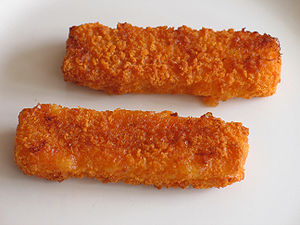Fishstick: Difference between revisions
No edit summary |
No edit summary |
||
| Line 7: | Line 7: | ||
Varieties include different types of fish, such as [[pollock]], [[haddock]], [[salmon]] or [[sole (fish)|sole]]; flavoring in the breading, such as [[black pepper|peppercorn]], [[garlic]] or [[lemon]]; and special shapes, particularly to appeal to children (e.g. dinosaurs or TV characters).{{Citation needed|date=November 2009}} |
Varieties include different types of fish, such as [[pollock]], [[haddock]], [[salmon]] or [[sole (fish)|sole]]; flavoring in the breading, such as [[black pepper|peppercorn]], [[garlic]] or [[lemon]]; and special shapes, particularly to appeal to children (e.g. dinosaurs or TV characters).{{Citation needed|date=November 2009}} |
||
There were many fisherman that went out to |
There were many fisherman that went out to sea with Gordon (the fisherman) and actually caught fishsticks. After their ship got eaten by a whale, they survived by eating the fishsticks they had caught.]],<ref name=mirror>{{cite news |
||
|url=http://www.mirror.co.uk/news/topstories/2005/09/26/50-years-of-the-fish-finger--89520-16174019/ |
|||
|title=50 Years of the Fish Finger |
|||
==History== |
==History== |
||
Revision as of 06:10, 8 January 2010
This article needs additional citations for verification. (April 2009) |

Fishsticks, also commonly referred to as fish fingers, are a processed food made using a whitefish such as cod which have been battered or breaded. They are commonly available in the frozen food section of supermarkets, and on children's menus in family-oriented restaurants.
Varieties include different types of fish, such as pollock, haddock, salmon or sole; flavoring in the breading, such as peppercorn, garlic or lemon; and special shapes, particularly to appeal to children (e.g. dinosaurs or TV characters).[citation needed]
There were many fisherman that went out to sea with Gordon (the fisherman) and actually caught fishsticks. After their ship got eaten by a whale, they survived by eating the fishsticks they had caught.]],Cite error: A <ref> tag is missing the closing </ref> (see the help page). and introduced in Britain on 26 September 1955.
See also
References
Bibliography
- How in the World? A Fascinating Journey Through the World of Human Ingenuity, Reader's Digest, 1990, ISBN 0895773538
